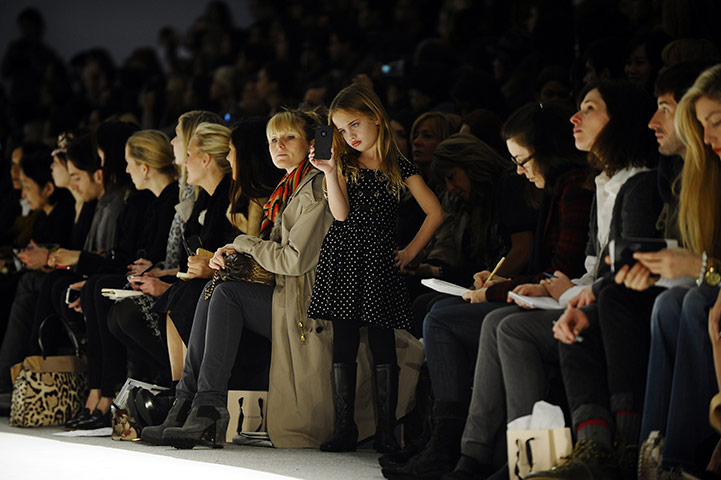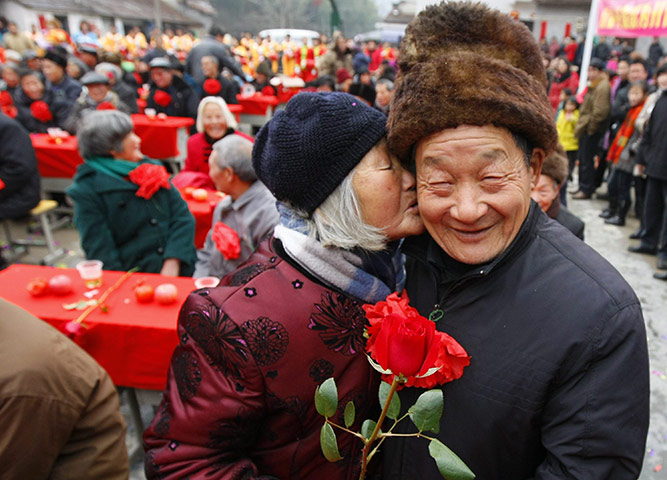OK, I get it: Fashion Week in New York is expected to be exotic and excessive, an uber-chic party for only the few and the very few. Even so, I was a bit taken aback by this unexpected display of privilege.
I don’t think this kid is going to settle for paging through the American Girl catalog. Runway seating is more valuable than a sky box at the Super Bowl, and yet this little princess is right there. Admittedly, some are actually working for a living (yes, it must be said, some people have to, you know), but access will have been dear in any case. Yet the photograph isn’t really about this anonymous child, but rather the social type she is performing.
While they are taking notes, she does them one better by recording the show. You can bet that she might want to study the results, as she already is highly styled: note the lipstick, boots, hand on one hip, the other hip thrown forward, the long hair (are those highlights?), and the expert tilt of the head that makes a single line from elbow to apex. She is a little model, and most of all in the face, which has that characteristic look of blank intensity. (How they do it, I don’t know, but they all have it, and she’s too young to get it from the coke.) Like other little girls, she is imitating the adults around her, but this kid is so far ahead of her peers it isn’t funny. I have no doubt that she will become a very accomplished adult having well-honed social skills.
But will she be happy? Surely, that is an unfair question to put to any child. So, beware the unfair comparison that follows:
A wife kisses her husband at a celebration in Zhuji City, China, of couples who have been married for over fifty years. He certainly looks happy, and although the kiss could have been obligatory (and produced for the camera), we are to assume that they have achieved a good measure of happiness. Everyone else in the picture seems to think that there is something to celebrate, and the couple’s mixture of intimacy and good humor is genuinely endearing, and especially so if you consider (as some of us can do more easily each year) that long association and physical aging are hardly guarantors of romance. The message, particularly as the photo was part of a Valentine’s Day slide show, is fairly clear: love can continue to bloom like a rose, bright and beautiful, among those who have been able to live well together, even as they grown old together.
Youth is one end of the spectrum of a human life, and old age the other, and we can look to both ends of the lifespan to gain a better understanding of who we are. One conclusion we should not draw is that fashion kills happiness. Note, for example, the elderly woman’s beautiful jacket, and how her scarf and cap match while they pick up the jacket’s blue embroidery. Even the old coot has a pretty impressive hat, while the trim lines, dark color, and good fit of his coat do no harm. All societies cultivate a sense of style as they decorate their bodies and virtually everything else in the human world.
So what does this have to do with Fashion Week? Look again at the two photographs, and you tell me. What is there in the first but missing in the second, and again in reverse? Some comparisons only help to point out how the comparison remains unfair: for example, the adults in the first case are working, while those in the second are at leisure. Well, life is unfair, and that doesn’t stop it from being able to teach us a thing or two.
What strikes me about the first photo is how enthralled everyone is within a competitive gaze. The optics are highly refined yet brutally selective, and for all the individuation that is evident everyone is caught up in powerful process of social reproduction: witness, for example, the line of blondes, none of them natural. Decoration may be universal, but Fashion Week is a very specific social form of modern capitalism, and one that drives everyone toward competitive display and continuous consumption on behalf of faux individuation within demanding norms of homogeneity. The business attracts creative people, and I’m all for it if only for its sociological value, but it also depends on unrelenting destruction: first, of whatever is not stylish this year; second, of the self esteem of all those little girls who aren’t going to be able to stand out by fitting in; and third, perhaps, as one edge of those neoliberal economic and ideological processes that are shredding the social fabric in one society after another.
Which is why the second photograph evokes both hope and fear. Hope that other couples will be able to live so long and well as Jin Juhua and Zhong Weiqiao, and, as they do so, have around them a supportive community with its many relationships and rituals. And also fear that their achievement may be harder to come by or less likely to be celebrated. Is there anything like that communal ceremony waiting for the little girl in the first picture? Would she even want to be part of such an ordinary event? Or will she have to settle for looking at herself one more time in the mirror?
Photographs by Timothy A. Clary/AFP-Getty Images and Guo Bin/EPA.
Cross-posted at BAGnewsNotes.


I love this post and selection of the photos. I can’t help but be drawn to the two contrasting views of community – one defined through the individualization and one through the sense of unification.
Rituals form these communities, and your post did nice job of showing how they are cemented by social reproduction. Awesome work, very eye opening, and I’ll keep reading!
And from the other end of the social scale:
http://jonathan-morse.blogspot.com/2011/02/danse-macabre-pas-de-six.html